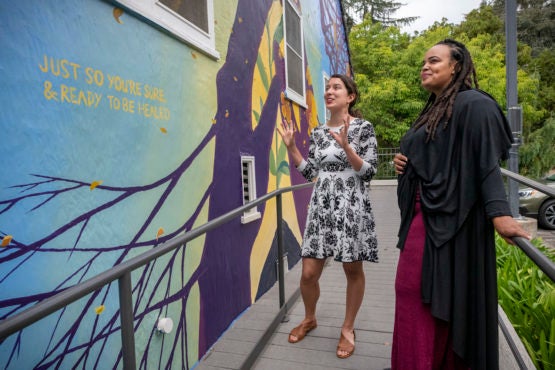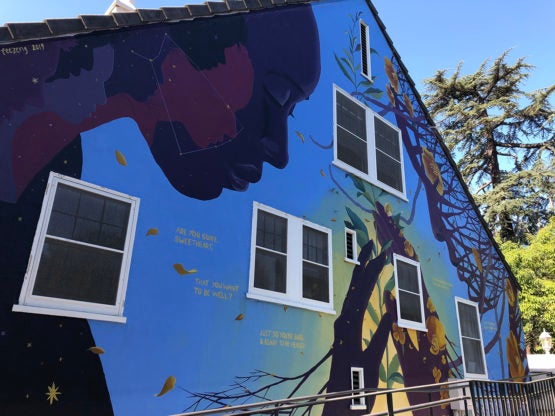New Stanford mural connects campus to local nature, diversity
Visit Harmony House, which is located on Lomita Drive, across the street from the Papua New Guinea Sculpture Garden, to see the newest work of public art on campus. It will remain in place through the 2019-20 academic year.
In the waning days of spring quarter, Mother Earth appeared on campus.
She arrived without fanfare, although there was music and spontaneous dancing as artist Jess X. Snow painted a Mother Earth figure – made of branches and native California poppies – on an exterior wall of Harmony House, a community center for undergraduate artists.
In the mural, Mother Earth offers her healing powers to a young woman on the opposite side of the wall. They reach toward each other, their hands mingling within the sunlit leaves of a native sage that rises to the building’s gable and tilts toward sky and sun.

Evelyn María Anderson, student program manager at Institute for Diversity in the Arts, left, and A-lan Holt, director, discuss a new outdoor mural installed in early June at Harmony House, a community center for undergraduate artists. (Image credit: L.A. Cicero)
The mural, which was completed in early June and will remain through the 2019-20 academic year, features silhouettes of Stanford students whose images are sprinkled with stars.
As visitors walk from one end of the mural to the other up a gently rising sidewalk, they will see quotes from The Salt Eaters, the 1980 novel by Toni Cade Bambara, including its provocative opening line, “Are you sure, sweetheart, that you want to be well?”
When Faith Kazmi, director of the Women’s Community Center, caught a glimpse of the new mural on her drive into work one morning, she said it took her breath away.
“Then it grounded me in a deeper breath than I’ve felt in a long while on campus,” she said in an email to Evelyn María Anderson, the student program coordinator at the Institute for Diversity in the Arts (IDA) and one of the leaders of the mural project.
“I need to spend more time in front of the piece for sure,” Kazmi said, “but from what I’ve seen, this contribution to Stanford is so powerful and needed.”
IDA, which commissioned the mural for its offices, Harmony House, worked closely with students, faculty, staff, alumni, visiting artists and university arts leaders on the project during the 2018–19 academic year.
“Students were our North Star and compass”
A-lan A. Holt, the newly appointed director of IDA, said the organization sought input on the mural’s design from students at every opportunity.
“We talked about it at our free Wednesday night dinners, which would always bring a great group of folks together,” she said. “We talked about it during out workshops with visiting artists. We talked about it with our student fellows. We talked about it during our academic course, Long Live Our 4 Billion Year-Old Mother: Black Feminist Praxis, Indigenous Resistance, and Cultures of Queer Possibility.”
Holt said students played a central role in conversations about the design.
“Students were definitely our North Star and compass,” she said. “We followed their lead on everything, including imagery, vibe and feel. Some of them even served as models for the actual images of figures in the mural. They helped pick the quotes and helped paint.”
Holt said the mural honors the communities of color whose histories are intertwined with Stanford, dating back to the Muwekma Ohlone people, as well as the black artists and activists and the queer artists and activists of Stanford.
Holt believes the mural’s healing theme will resonate within the Stanford community.
“That’s a theme that touches all of us, whether you graduated from Stanford in 1962 or will be graduating in 2022,” she said.
“A beautiful addition to the neighborhood”
Gina Hernandez-Clarke, who teaches a course on community-based and public art offered by the Stanford Center for Comparative Studies in Race and Ethnicity, praised the mural’s visual layout, images and colors.
Hernandez-Clarke, director of undergraduate arts education, described the mural as a “great new contribution” to the collection of murals at Stanford, whose treasures include a mural painted on the interior and exterior walls of Casa Zapata, a student residence hall.
“It is a beautiful and uplifting addition to the neighborhood,” Hernandez-Clarke said.
While the newest mural on campus was completed just as students left for summer break, IDA plans to hold a public celebration of the Harmony House mural when students return in the fall.
To see the new mural, visit Harmony House, which is located at 561 Lomita Drive, across the street from the Papua New Guinea Sculpture Garden.
The Harmony House Mural project was supported by the Institute for Diversity in the Arts; the Office of the Vice President for the Arts; the Women’s Community Center; Queer Student Resources; the Office of Sexual Assault & Relationship Abuse Education & Response (SARA); and the Office of the Vice Provost for Undergraduate Education.

